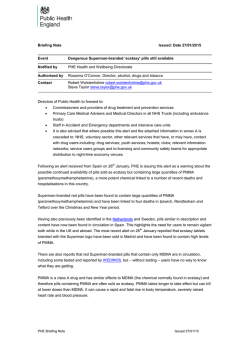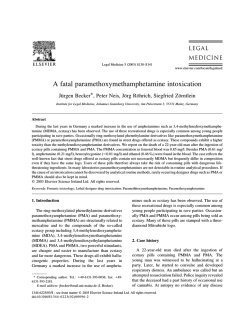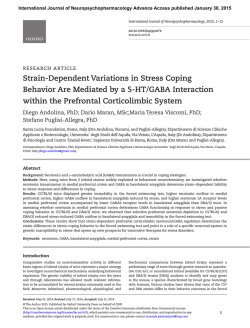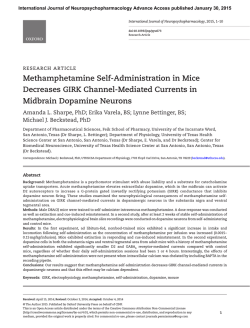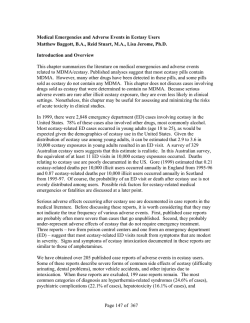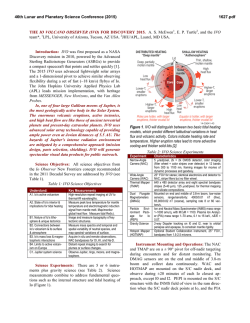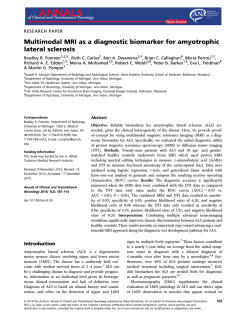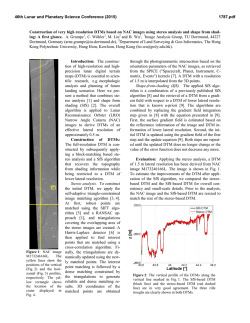
NTs - University of New Mexico
Journal of Neurochemistry, 2004, 91, 852–859 doi:10.1111/j.1471-4159.2004.02763.x Serotonin–GABA interactions modulate MDMA-induced mesolimbic dopamine release Michael G. Bankson and Bryan K. Yamamoto Laboratory of Neurochemistry, Department of Pharmacology and Experimental Therapeutics, Boston University School of Medicine, Boston, Massachusetts, USA Abstract 3,4,-Methylenedioxymethamphetamine (MDMA; ‘ecstasy’) acts at monoamine nerve terminals to alter the release and re-uptake of dopamine and 5-HT. The present study used microdialysis in awake rats to measure MDMA-induced changes in extracellular GABA in the ventral tegmental area (VTA), simultaneous with measures of extracellular dopamine (DA) in the nucleus accumbens (NAC) shell. (+)-MDMA (0, 2.5, 5 and 10 mg/kg, i.p.) increased GABA efflux in the VTA with a bell-shaped dose–response. This increase was blocked by application of TTX through the VTA probe. MDMA (5 mg/kg) increased 5-HT efflux in VTA by 1037% (p < 0.05). The local perfusion of the 5-HT2B/2C antagonist SB 206553 into the VTA reduced VTA GABA efflux after MDMA from a maximum of 229% to a maximum of 126% of basal values (p < 0.05), while having no effect on basal extracellular GABA concentrations. DA concentrations measured simultaneously in the NAC shell were increased from a maximum of 486% to 1320% (p < 0.05). The selective DA releaser d-amphetamine (AMPH) (4 mg/kg) also increased VTA GABA efflux (180%), did not alter 5-HT and increased NAC DA (875%) (p < 0.05), but the perfusion of SB 206553 into the VTA failed to alter these effects. These results suggest that MDMA-mediated increases in DA within the NAC shell are dampened by increases in VTA GABA subsequent to activation of 5-HT2B/2C receptors in the VTA. Keywords: dopamine, gamma amino butyric acid, 3, 4-methylenedioxymethamphetamine, nucleus accumbens, serotonin, ventral tegmental area. J. Neurochem. (2004) 91, 852–859. 3,4,-Methylenedioxymethamphetamine (MDMA; ‘e’; ‘x’; ‘ecstasy’) is an amphetamine derivative that is being increasingly abused across the US and worldwide. Some of the unique properties of MDMA that make it subjectively different from the parent compound, d-amphetamine (AMPH), and probably account for its continued popularity, include cognitive enhancement, feelings of warmth toward others, abatement of anxiety and enhanced perceptual ability (Vollenweider et al. 1998). The stimulant and rewarding properties of MDMA, as well as the other amphetamines, are thought to arise in part from the ability of these drugs to activate mesolimbic dopamine (DA) neurons in the ventral tegmental area (VTA) that project to the nucleus accumbens (NAC) (Hoebel 1985; Gold et al. 1989a; Kelley and Delfs 1991). Both MDMA and AMPH act primarily by releasing DA from nerve terminals via reversal of the dopamine transporter (Fischer and Cho 1976; Holmes and Rutledge 1976). The enhancement of DA release in NAC is thought to mediate their locomotor activating and rewarding properties (Gold et al. 1989b). Compared with AMPH, MDMA binds with higher affinity to the serotonin re-uptake transporter to release 5-HT (Johnson et al. 1991; Rudnick and Wall 1992). Thus, the unique properties of MDMA that differentiate it from the effects of other amphetamines in both human (Greer and Tolbert 1986) and animal (Paulus and Geyer 1992) studies may arise from the simultaneous release of 5-HT and DA. Another difference between MDMA and amphetamine that may account for the unique pharmacological profile of MDMA is that MDMA, unlike AMPH, causes both transporter-mediated and impulse-mediated DA release. The impulse-mediated release of DA produced by MDMA 852 Received June 11, 2004; revised manuscript received July 15, 2004; accepted July 16, 2004. Address correspondence and reprint requests to Bryan K. Yamamoto PhD, Department of Pharmacology and Experimental Therapeutics, L-613, Boston University School or Medicine, Boston, MA 02118, USA. E-mail: [email protected] Abbreviations used: AMPH, d-amphetamine; DA, dopamine; GABA, gamma amino butyric acid; 5-HT, 5-hydroxytryptamine, serotonin; MDMA, 3,4-methylenedioxymethamphetamine; VTA, ventral tegmental area. 2004 International Society for Neurochemistry, J. Neurochem. (2004) 91, 852–859 MDMA and VTA GABA 853 appears to be dependent on 5-HT transmission (Koch and Galloway 1997) and may be explained by the stimulatory effects of 5-HT1B/1D (Hallbus et al. 1997), 5-HT2A (Schmidt et al. 1992a), 5-HT3 (De Deurwaerdere et al. 1998), and 5-HT6 (Minabe et al. 2004) receptors on DA release. The impulse dependency of MDMA-induced DA release is consistent with the findings that MDMA-induced increases in extracellular DA in the striatum are attenuated by the sodium channel blocker TTX (Yamamoto et al. 1995) and that pharmacological inhibition of MDMA-induced 5-HT release attenuates MDMA-induced striatal DA release (Gudelsky and Nash 1996; Koch and Galloway 1997). The premise that MDMA-induced DA release is secondary, in part, to MDMA-induced 5-HT release is also consistent with locomotor studies showing that MDMAinduced activity is blocked by 5-HT1B (Callaway et al. 1992; McCreary et al. 1999) or 5-HT2A (Kehne et al. 1996) antagonists. Alternatively, blockade of 5-HT2B/2C receptors has been shown to greatly enhance MDMA-induced locomotion (Bankson and Cunningham 2002). Thus, there are opposing effects of 5-HT on the behavioral effects of MDMA, a 5-HT1B/2A stimulatory effect and a 5-HT2C inhibitory effect. One explanation for these behavioral findings is that activation of 5-HT2C receptors may act in opposition to the stimulatory effects of 5-HT1B and 5-HT2A receptors by limiting MDMA-induced DA release in NAC (Gold et al. 1989). While the stimulatory role of the 5-HT2A receptor is consistent with these receptors being located on and directly stimulating mesolimbic DA neurons (Doherty and Pickel 2000), the role of 5-HT1B receptors in facilitating, and the role of 5-HT2C receptors in dampening MDMAinduced motor activation, may be mediated through changes in mesolimbic GABA. GABA is known to decrease DA cell firing in the VTA (Kiyatkin and Rebec 1998). 5-HT2C receptors located on non-dopaminergic (presumably GABA) neurons in the VTA increase GABA transmission (Stanford and Lacey 1996). Therefore, 5-HT2C receptors may decrease DA cell firing through increases in GABA release in the VTA. Consistent with these findings, selective stimulation of 5-HT2C receptors decreases DA release in the NAC shell and decreases the firing rate of mesolimbic DA neurons (Di Giovanni et al. 2000). Conversely, antagonism of this receptor increases the firing rate of VTA DA neurons and increases DA release in the NAC (Di Matteo et al. 1999). While these studies are suggestive of a modulatory role of 5-HT2C receptors on VTA neurons and DA release in the NAC shell, the systemic administration of 5-HT agonists and antagonists was used and thus do not address the specific locus of action or whether 5-HT2C receptors dampen DA transmission directly or indirectly through the enhancement of GABAergic transmission within the VTA. Previous work from this laboratory has shown that the non-selective 5-HT2A/2C receptor antagonist ritanserin attenuates MDMA-induced increases in DA release in the nigrostriatal pathway (Yamamoto et al. 1995) and suggests that 5-HT2A receptor activation is necessary for MDMAinduced DA release (Schmidt et al. 1992b); however, this study did not address the specific contribution of 5-HT2C receptors. Furthermore, this prior work did not examine how MDMA-induced DA release is regulated in the mesolimbic pathway. Di Giovanni et al. (2000) have shown that mesolimbic 5-HT2C receptors exert greater inhibitory control over DA release than do nigrostriatal 5-HT2C receptors, but no studies to date have used localised blockade of 5-HT2C receptors in the VTA to evaluate their involvement in controlling mesolimbic DA release after MDMA administration. Based on the aforementioned behavioral, neurochemical and anatomical studies, the 5-HT2C receptor in the VTA may oppose and modulate the stimulatory effects of 5-HT1B and 5-HT2A receptors to limit the impulse-mediated release of DA in the NAC shell, and thereby contribute to the unique neurochemical and behavioral profile of MDMA relative to the actions of AMPH. The hypothesis of the current study is that MDMA-induced DA release in the NAC shell differs from that of AMPH-induced DA release in that DA release produced by MDMA is dampened by the enhancement of GABA transmission in the VTA via the activation of the 5-HT2C receptor. To test this hypothesis, extracellular DA within the NAC shell produced by MDMA or AMPH was measured simultaneously with changes in the extracellular concentrations of GABA within the VTA in the presence or absence of the local perfusion of the VTA with a 5-HT2B/2C antagonist. Materials and methods Subjects Male Sprague-Dawley rats (Harlan Sprague-Dawley, Indianapolis, IN, USA) weighing 175–250 g at the beginning of experimental procedures were housed in groups of three in a temperature (21– 23C) -controlled environment for at least 2 days prior to experiments. Food and water were available ad libitum. Lighting was maintained under a 12-h light-dark cycle (lights on 07.00– 19.00 h). All experimental procedures were performed between 07.00 and 19.00 h and were carried out in accordance with the National Institutes of Health Guide for the Care and Use of Laboratory Animals. Drugs SB 206553 [N-3-pyridinyl-3,5-dihydro-5-methylbenzo(1,2-b:4,5b¢)dipyrrole-1(2H)carboxamide] and TTX (tetrodotoxin) were obtained from Research Biochemicals Inc. (Natick, MA, USA). (+)-MDMA (3,4-methlenedioxymethamphetamine) was obtained from the National Institutes on Drug Abuse (NIDA, Research Triangle Park, NC, USA). Doses refer to the weight of the salt. MDMA was administered intraperitoneally in a volume of 1 mL per kg of body weight. SB 206553 (5 lM) and TTX (1 lM) were 2004 International Society for Neurochemistry, J. Neurochem. (2004) 91, 852–859 854 M. G. Bankson and B. K. Yamamoto administered by reverse dialysis in modified Dulbecco’s buffered saline (137 mM NaCl, 2.7 mM KCl, 0.5 mM MgCl2, 8.1 mM Na2HPO4, 1.5 mM KH2PO4, 1.2 mM CaCl2 and 5 mM d-glucose, pH 7.4). Surgical procedures After acclimation to the colony room, all rats were anesthetized with a combination of xylazine (12 mg/kg) and ketamine (80 mg/kg) and placed into a Kopf stereotaxic frame. The skull was exposed and a microdialysis probe placed in the ventral tegmental area (VTA) (4.8 mm posterior, ±0.8 mm medial, 9 mm ventral to bregma). For dual probe studies, probes were placed in both the VTA and nucleus accumbens shell (NAC) 1.7 mm anterior, ±1.1 mm medial and 9.1 mm ventral to bregma at an angle of 15 degrees. The probes were constructed as previously described (Pehek et al. 1990) and have an active membrane length of 1.75 mm. The probes and a metal male connector were secured to the skull with three stainless steel screws and cranioplastic cement. Microdialysis procedures The day after probe insertion, the modified Dulbecco’s phosphatebuffered saline medium was pumped through the microdialysis probes with a Harvard Model 22 syringe infusion pump (Hollison, MA, USA) at a rate of 2 lL/min. A 1.5-h perfusion period was allowed prior to sample collection. Thirty-minute samples were then collected. Four baseline samples were collected after which SB 206553 or TTX was added to the perfusion medium of the probe positioned in the VTA. MDMA or saline was injected 2 h after initiation of the perfusion of TTX (1 lM) or SB 206553 (5 lM) into the VTA. In the single probe experiments that measured GABA in VTA, MDMA was injected 30 min after SB 206553 infusion into VTA. Samples from the VTA and NAC shell were collected for 3 h. For the experiments that involved a single probe implantation in the VTA, MDMA, AMPH or saline control was injected immediately after four baseline samples and samples taken every 30 min for 3 h. HPLC analysis of monoamines and GABA Microdialysis samples were assayed for dopamine, 5-HT, and GABA by high-performance liquid chromatography with electrochemical detection. Three-point standard curves were evaluated periodically to determine peak identity and linearity of the concentration–response. Single point calibration was used on a daily basis to quantify peak height. Separation was achieved with a C18 column (100 · 2.0 mm, 3 lm particle size; Phenomenex, Torrance, CA, USA). The mobile phase for detection of DA, 5-HT and metabolites (pH 4.2) consisted of 32 mM citric acid, 54.3 mM sodium acetate, 0.074 mM EDTA, 0.215 mM octyl sodium sulfate and 3% methanol. GABA was derivatized with o-phthaldialdehyde and sodium sulfite (Smith and Sharp 1994). Briefly, 2 lL of the stock derivatization reagent containing 22 mg of OPA, 0.5 mL of 100% ethanol, 0.5 mL of 1 M sodium sulfite and 9 mL of sodium borate buffer (0.4 M boric acid, pH 10.4) was added to 20 lL of dialysate or standard, vortexed and allowed to react for 5 min before injecting onto a C18 column (100 · 2.0 mm, 3 lm particle size; Phenomenex). GABA was eluted using a mobile phase consisting of 0.1 M Na2HPO4 and 0.1 mM EDTA in 10% methanol at pH ¼ 4.4. Compounds were detected with an LC-4C amperometric detector (Bioanalytical Systems, West Lafayette, IN, USA) or DecadeR. detector (Antec-Leyden, the Netherlands) with a 6-mm glassy carbon working electrode maintained at a potential of +0.65 V (DA, 5-HT) or 0.7 V (GABA) relative to a Ag/AgCl reference electrode. Statistical analyses One-way way repeated-measures analyses of variance (ANOVA) (AUC), or two-way ANOVAs (time-course) were computed to compare rats treated with drugs across all sample collection times. Post-hoc Tukey’s HSD tests were used to analyze any significant treatments at specific time points. Average baseline values for all experiments was calculated from the four samples prior to control, TTX or SB 206553 pre-treatment. Results MDMA effects on VTA GABA: interaction with SB 206553 and TTX Across groups, basal GABA in the VTA was 22.8 ± 2.3 nM; basal DA in the NAC shell was 0.48 ± 0.05 nM; and basal 5-HT in the VTA was 0.14 ± 0.03 nM. MDMA significantly increased extracellular GABA concentrations in the VTA (F3,24 ¼ 6.31, p < 0.05) compared with vehicle controls (Fig. 1). MDMA (5 mg/kg) had the greatest effect on VTA GABA release and was therefore used in all subsequent experiments. Pre-treatment with SB 206553 or TTX into the VTA before systemic administration of MDMA (5 mg/kg) significantly attenuated the increases in GABA produced by MDMA (F2,17 ¼ 7.41, p < 0.05). No differences were observed in basal VTA GABA efflux during SB 206553 or TTX infusion prior to MDMA administration. Fig. 1 Extracellular GABA concentrations in VTA: area under the curve (AUC). MDMA was injected at the indicated dose after a 2-h baseline. n ¼ 6–8 rats/group. SB 206553 (SB) (5 lm) was added to dialysis medium 30 min before systemic MDMA. TTX was added to the dialysis medium 2 h before systemic MDMA. Bars represent area under the curve (± SEM) for 3-h post MDMA injection (six samples). *p < 0.05 compared with saline treatment; #p < 0.05 compared with MDMA (5 mg/kg, i.p.) treatment by one way ANOVA. Dose of MDMA in mg/kg i.p. (2.5, 5, or 10); SB-MDMA 5: SB 206553 with MDMA at 5 mg/kg i.p. 2004 International Society for Neurochemistry, J. Neurochem. (2004) 91, 852–859 MDMA and VTA GABA 855 Time course of SB 206553 on MDMA-induced GABA in VTA MDMA produced an overall increase in extracellular GABA concentrations in the VTA compared with saline controls (F1,151 ¼ 6.86, p < 0.05) (Fig. 2) MDMA-induced GABA concentrations were significantly different from saline controls at all time points after MDMA administration (p < 0.05). Pre-treatment with SB 206553 into the VTA significantly attenuated the MDMA-induced increases in GABA over the time course of the experiment (F13,151 ¼ 1.87, p < 0.05). SB + MDMA produced increases in VTA GABA which were significantly less than MDMA alone at the 5-, 5.5-, 6- and 7-h time points (Tukey post hoc, p < 0.05). Time course of SB 206553 effects on MDMA-induced DA in NAC shell MDMA produced an overall increase in extracellular DA concentrations in the NAC shell compared with saline controls (F1,134 ¼ 12.73.86, p < 0.05) and over the time course of the dialysis experiment (F13,134 ¼ 7.72, p < 0.05) (Fig. 3). MDMA produced an increase in DA which was significantly different compared with saline controls at all time points after MDMA administration, except for 7 h, p < 0.05. Pre-treatment with SB 206553 into the VTA significantly augmented MDMA-induced increases in DA concentrations in NAC shell (F1,137 ¼ 6.59, p < 0.05), and was significantly different from MDMA alone at the 4.5-, 5- and 5.5-h time points, p < 0.05. Fig. 2 MDMA effects on GABA concentrations in VTA. Dialysis samples were collected from the VTA of rats treated with SB 206553 (SB) (5.0 lm) or vehicle was reverse dialyzed into the VTA 2 h prior to systemic administration of MDMA (5 mg/kg i.p.). n ¼ 6–8/group. #p < 0.05 compared with vehicle + MDMA; *p < 0.05 compared with vehicle + saline (SAL) rats; two-way repeated measures ANOVA. Hatched horizontal bar indicates the duration of SB into the VTA. Arrow indicates time of systemic MDMA administration. Error bars represent ± SEM. Fig. 3 MDMA effects on DA concentrations in NAC. Dialysis samples were collected from the NAC of rats treated with SB 206553 (SB) (5.0 lm) or vehicle that was reverse dialyzed into the VTA for 2 h prior to systemic administration of MDMA (5 mg/kg i.p.) n ¼ 6–8/group. #p < 0.05 compared with vehicle l + MDMA; *p < 0.05 compared with vehicle + saline (SAL) rats; two-way repeated measures ANOVA. Hatched horizontal bar indicates duration of SB into the VTA. Arrow indicates time of systemic MDMA administration. Error bars represent ± SEM. Comparison of MDMA and AMPH-induced 5-HT concentrations in VTA MDMA produced an overall increase in extracellular 5-HT concentrations in the VTA compared with AMPH (F1,105 ¼ 41.89, p < 0.05) and over the time course of the dialysis experiment (F13,105 ¼ 7.57, p < 0.05) (Fig. 4). MDMAinduced 5-HT levels were significantly different from AMPH control for all time points after MDMA administration except at 7 h, p < 0.05. Fig. 4 MDMA and AMPH effects on 5-HT concentrations in the VTA. Dialysis samples were collected from the VTA of rats treated with systemic administration of MDMA (5 mg/kg i.p.) or d-amphetamine (AMPH) (4 mg/kg i.p.). n ¼ 5/group. *p < 0.05 by one-way ANOVA. Arrow indicates time of systemic MDMA or AMPH administration. Error bars represent ± SEM. 2004 International Society for Neurochemistry, J. Neurochem. (2004) 91, 852–859 856 M. G. Bankson and B. K. Yamamoto Fig. 5 AMPH effects on GABA concentrations in VTA. Dialysis samples were collected from the VTA of rats treated with SB 206553 (SB) (5.0 lm) or vehicle that was reverse dialyzed into the VTA 2 h prior to systemic administration of d-amphetamine (AMPH) (4 mg/kg i.p.). n ¼ 6–8/group. #p < 0.05 compared with vehicle + AMPH; *p < 0.05 compared with vehicle + saline (SAL) rats by two-way repeated measures ANOVA. Hatched horizontal bar indicates duration of SB into the VTA. Arrow indicates time of systemic AMPH administration. Error bars represent ± SEM. Time course of SB 206553 on AMPH-induced GABA in VTA AMPH produced an overall increase in extracellular GABA concentrations in the VTA compared with saline controls (F1,151 ¼ 6.86, p < 0.05) and over the time course of the experiment (F13,151 ¼ 3.29, p < 0.05) (Fig. 5). GABA levels were significantly different from saline control at the 4.5-, 5.5- and 7-h time points, p < 0.05. Pre-treatment with SB 206553 alone into the VTA had no effect on basal concentrations of GABA compared with vehicle-infused controls during the time period (2–4 h time points) prior to the injection of AMPH. Pre-treatment with SB 206553 into the VTA had no effect over time or compared with AMPH alone. Time course of SB 206553 effects on AMPH-induced DA in NAC AMPH produced an increase in extracellular DA concentrations in the NAC compared with saline controls (F1,146 ¼ 8.84, p < 0.05) and over the time course of the dialysis study (F13,146 ¼ 13.54, p < 0.05) (Fig. 6). AMPH produced DA levels that were significantly different from saline controls for all time points after drug injection except for 6.5 and 7 h, p < 0.05. Pre-treatment with SB 206553 into the VTA had no effect over time or compared with AMPH alone. Discussion These studies are the first to demonstrate that MDMA elicits a dose- and impulse-dependent increase in extracellular Fig. 6 AMPH effects on DA concentrations in NAC. Dialysis samples were collected from the NAC of rats treated with SB 206553 (SB) (5 lM) or vehicle that was reverse dialyzed into the VTA for 2 h prior to systemic administration of d-amphetamine (AMPH) (4 mg/kg i.p.) n ¼ 6–8/group. #p < 0.05 compared with vehicle + saline (SAL) by two-way repeated measures ANOVA. Hatched horizontal bar indicates duration of SB into the VTA. Arrow indicates time of systemic AMPH administration. Error bars represent ± SEM. GABA concentrations in the VTA (Fig. 1). The results also show that unlike d-amphetamine (Figs 5 and 6), the increase in extracellular concentrations of 5-HT in the VTA produced by MDMA (Fig. 4) acts at 5-HT2C receptors to control both VTA GABA as well as NAC shell DA release (Figs 2 and 3). Although the neuronal origin of GABA has been questioned (Timmerman and Westerink 1997), the current findings suggest that the increase in GABA produced by MDMA and 5-HT2C activation is dependent upon impulse flow from GABA afferents or depolarization of GABAergic soma. The addition of TTX to the dialysis medium blocked the MDMA-induced increase in VTA GABA but did not alter the basal concentration of GABA. This complete blockade of MDMA-induced GABA efflux suggests that MDMA elicits GABA release through impulse-mediated, neuronal mechanisms, while the basal concentrations of GABA are derived from impulse-independent or non-neuronal sources (Matuszewich and Yamamoto 1999). The effect of MDMA on extracellular GABA concentrations in the VTA produced a bell-shaped dose–response curve (Fig. 1). Although increasing doses in the lower range resulted in progressive increases in extracellular GABA, the higher dose (10 mg/kg) was less effective, possibly due to rapid desensitization of 5-HT2C receptors (Berg et al. 2001) and the predicted greater 5-HT release and stimulatory effect on 5-HT2C receptors. In contrast to the bell-shaped dose– response for MDMA-induced changes in VTA GABA, several studies have shown a positive correlation between striatal and accumbal DA release and dose of MDMA across the range of doses tested (Nash 1990; Kalivas et al. 1998; Kankaanpaa et al. 1998), indicating that the 5 mg/kg dose of 2004 International Society for Neurochemistry, J. Neurochem. (2004) 91, 852–859 MDMA and VTA GABA 857 MDMA used in the present study is submaximal for eliciting the release of DA. Although the present study only measured DA release after 5 mg/kg of MDMA, this dose produced a maximal effect on VTA GABA, suggesting that at lower doses of MDMA, DA release occurs despite elevated VTA GABA. The 10 mg/kg dose of MDMA produced smaller increases in VTA GABA, suggesting that the impact of of 5-HT2C receptors and GABA release in the VTA may have greater importance at lower doses of MDMA. Previous work from this laboratory has shown an MDMAinduced decrease in GABA concentrations in the substantia nigra (Yamamoto et al. 1995). This result is different from the present study showing increases in GABA in the VTA. Thus, MDMA may be affecting extracellular GABA concentrations by different mechanisms in the substantia nigra as compared with the VTA. This premise is consistent with reports that the 5-HT2C receptor exerts a greater inhibitory influence over mesolimbic DA than it does over the nigrostriatal DA system (Di Giovanni et al. 2000). Furthermore, ritanserin, a non-selective 5-HT2A/2C antagonist, was used in the previous study that focused on the nigrostriatal pathway and suggested a stimulatory effect of 5-HT2A receptors on DA release in contrast to the present study showing an inhibitory effect of 5-HT2B/2C receptors in the VTA mediated through the increase in GABA. The contrasting effects on mesolimbic versus nigrostriatal dopaminergic systems are particularly interesting given the findings that MDMA is less readily self-administered compared with other psychostimulant drugs of abuse (Schenk et al. 2003; Fantegrossi et al. 2004). SB 206553 blocks both 5-HT2B and 5-HT2C receptors (Kennett et al. 1996) and blockade of either may account for the attenuation of MDMA-induced GABA efflux in the VTA and attenuation in DA release in the NAC shell. However, modest densities of 5-HT2B receptors are found in brain compared with the more highly expressed 5-HT2C receptor (Duxon et al. 1997; Barnes and Sharp 1999). Furthermore, another selective 5-HT2C receptor antagonist, SB 242084, which has little affinity for 5-HT2B receptors (Kennett et al. 1997), also increases basal mesolimbic DA efflux (Di Matteo et al. 1999) and further supports the conclusion that 5-HT2C blockade modulates DA release in the NAC shell. The application of the 5-HT2B/2C antagonist SB 206553 into the VTA did not alter basal concentrations of GABA but attenuated the MDMA-induced increase in extracellular GABA while dramatically and simultaneously increasing MDMA-induced DA efflux in the NAC shell (Figs 2 and 3). The lack of an effect of SB 206553 on basal extracellular concentrations of GABA suggests that 5-HT via 5-HT2B/2C receptors do not have a tonic stimulatory effect on extracellular GABA in the VTA. While these studies do not provide direct evidence of a link between VTA GABA release and MDMA-induced DA release, several reports indicate that GABA exerts an inhibitory influence on VTA DA neurons. Activation of 5-HT2C receptors in VTA is known to inhibit stress-induced, but not basal DA release and blockade of these receptors in the VTA increases DA release (Pozzi et al. 2002). The GABAB agonist baclofen inhibits DA release in the prefrontal cortex (Westerink et al. 1998) and NAC (Xi and Stein 1998, 1999) when infused into the VTA. These findings in combination with the current results suggest that 5-HT2C mediated elevations of GABA concentrations in the VTA may act to limit the magnitude of MDMA-induced DA release. At first glance, these results showing an inhibition of VTA-NAC DA transmission via 5-HT2C receptors may appear to be inconsistent with previous studies showing a 5-HT mediated, impulse dependent enhancement of MDMAinduced DA release (Gudelsky and Nash 1996; Koch and Galloway 1997). However, the inhibitory effect of 5-HT2C activation on VTA-NAC DA release is countered by an opposing action of 5-HT1B receptors. In fact, 5-HT1B activation in the VTA has been shown to inhibit local GABA efflux (Yan and Yan 2001) and elicit DA release in the NAC (Guan and McBride 1989). This suggests that MDMA-induced increases in extracellular 5-HT concentrations can also stimulate 5-HT1B receptors to decrease VTA GABA concentrations and disinhibit VTA DA neurons projecting to the NAC. This is consistent with locomotor studies indicating that MDMA-induced hyperactivity requires activation of 5-HT1B receptors (McCreary et al. 1999) and can be augmented or unmasked by 5-HT2B/2C antagonism (Bankson and Cunningham 2002). Thus, the pharmacological action of MDMA on DA release is a balance of the stimulation and inhibition of 5-HT1B and 5-HT2C receptors on GABA efflux, respectively. The lack of a complete reversal of MDMA-induced GABA by SB 206553 suggests that D1-mediated activation of mesolimbic GABA neurons also contributes to MDMAinduced GABA release (Cameron and Williams 1993, 1995). The resultant expression of MDMA-induced DA release may be dependent upon the relative balance of 5-HT2C, 5-HT1B, and D1 receptor activation. Thus, the impulse-dependency of MDMA-induced DA release in forebrain regions (Yamamoto et al. 1995) is mediated by a 5-HT1B receptor stimulatory and a 5-HT2C/D1 receptor inhibitory effect via a decrease and an increase, respectively, in GABA efflux in midbrain DA nuclei. In contrast to the partial modulation of DA release by impulse flow caused by MDMA, AMPH releases DA via an impulse-independent reversal of the DAT (Fischer and Cho 1976; Hurd and Ungerstedt 1989; Westerink et al. 1989). This transporter-mediated release of DA does not appear to be significantly influenced or counteracted by a presumed simultaneous inhibition of impulse-mediated NAC shell DA release produced by a D1-mediated increase in GABA transmission in the VTA. This lack of an influence of impulse flow on AMPH-induced DA release is consistent 2004 International Society for Neurochemistry, J. Neurochem. (2004) 91, 852–859 858 M. G. Bankson and B. K. Yamamoto with the finding that AMPH causes the release of DA in the absence of DA cell firing (Bunney et al. 1973). The present finding that blockade of 5-HT2C receptors in the VTA does not effect AMPH-induced GABA or DA release (Figs 5 and 6) highlights the significant difference between this drug and MDMA-induced DA release in the NAC shell (Figs 3 and 6). In conclusion, MDMA-induced DA release in the NAC shell is dampened by a 5-HT2C receptor-mediated increase in GABA within the VTA and is in marked contrast to the primarily impulse-independent and 5-HT-independent effects of AMPH on DA release. These findings may have important implications for the possible influence of prior exposure to MDMA-induced neurotoxicity to 5-HT neurons. The longterm decrease in 5-HT transmission produced by neurotoxic doses of MDMA could lead to a decreased activation of 5-HT2C receptors, a consequent loss of inhibitory GABAergic tone on mesolimbic DA transmission and, subsequently, an increased vulnerability to the DA-mediated rewarding effects of this and other psychostimulant drugs of abuse. Acknowledgements This work was supported by DA07427, DA16501 and a gift from Hitachi America Inc. References Bankson M. G. and Cunningham K. A. (2002) Pharmacological studies of the acute effects of (+)-3,4-methylenedioxymethamphetamine on locomotor activity: role of 5-HT(1B/1D) and 5-HT(2) receptors. Neuropsychopharmacology 26, 40–52. Barnes N. M. and Sharp T. (1999) A review of central 5-HT receptors and their function. Neuropharmacology 38, 1083–1152. Berg K. A., Stout B. D., Maayani S. and Clarke W. P. (2001) Differences in rapid desensitization of 5-hydroxytryptamine 2A and 5-hydroxytryptamine 2C receptor-mediated phospholipase C activation. J. Pharmacol. Exp. Ther. 299, 593–602. Bunney B. S., Aghajanian G. K. and Roth R. H. (1973) Comparison of effects of 1-dopa, amphetamine and apomorphine on firing rate of rat dopaminergic neurones. Nat. New Biol. 245, 123–125. Callaway C. W., Rempel N., Peng R. Y. and Geyer M. A. (1992) Serotonin 5-HT1-like receptors mediate hyperactivity in rats induced by 3,4-methylenedioxymethamphetamine. Neuropsychopharmacology 7, 113–127. Cameron D. L. and Williams J. T. (1993) Dopamine D1 receptors facilitate transmitter release 116. Nature 366, 344–347. Cameron D. L. and Williams J. T. (1995) Opposing roles for dopamine and serotonin at presynaptic receptors in the ventral tegmental area. Clin. Exp. Pharmacol. Physiol. 22, 841–845. De Deurwaerdere P., Stinus L. and Spampinato U. (1998) Opposite change of in vivo dopamine release in the rat nucleus accumbens and striatum that follows electrical stimulation of dorsal raphe nucleus: role of 5-HT3 receptors. J. Neurosci. 18, 6528–6538. Di Giovanni G. M. V., Di Mascio M. and Esposito E. (2000) Preferential modulation of mesolimbic vs. nigrostriatal dopaminergic function by serotonin (2C/2B) receptor agonists: a combined in vivo electrophysiological and microdialysis study. Synapse 35, 53–61. Di Matteo V., Di Giovanni G., Di Mascio M. and Esposito E. (1999) SB 242084, a selective serotonin 2C receptor antagonist, increases dopaminergic transmission in the mesolimbic system. Neuropharmacology 38, 1195–1205. Doherty M. D. and Pickel V. M. (2000) Ultrastructural localization of the serotonin 2A receptor in dopaminergic neurons in the ventral tegmental area. Brain Res. 864, 176–185. Duxon M. S., Kennett G. A., Lightowler S., Blackburn T. P. and Fone K. C. (1997) Activation of 5-HT2B receptors in the medial amygdala causes anxiolysis in the social interaction test in the rat. Neuropharmacology 36, 601–608. Fantegrossi W. E., Woolverton W. L., Kilbourn M., Sherman P., Yuan J., Hatzidimitriou G., Ricaurte G. A., Woods J. H. and Winger G. (2004) Behavioral and neurochemical consequences of longterm intravenous self-administration of MDMA and its enantiomers by rhesus monkeys 1. Neuropsychopharmacology 29, 1270–1281. Fischer J. F. and Cho A. K. (1976) Properties of dopamine efflux from rat striatal tissue caused by amphetamine and p-hydroxyamphetamine. Proc. West Pharmacol. Soc. 19, 179–182. Gold L. H., Geyer M. A. and Koob G. F. (1989a) Neurochemical mechanisms involved in behavioral effects of amphetamines and related designer drugs. NIDA Res. Monogr. 94, 101–126. Gold L. H., Hubner C. B. and Koob G. F. (1989b) A role for the mesolimbic dopamine system in the psychostimulant actions of MDMA. Psychopharmacology (Berl.) 99, 40–47. Greer G. and Tolbert R. (1986) Subjective reports of the effects of MDMA in a clinical setting. J. Psychoactive Drugs 18, 319– 327. Guan X. M. and McBride W. J. (1989) Serotonin microinfusion into the ventral tegmental area increases accumbens dopamine release. Brain Res. Bull. 23, 541–547. Gudelsky G. A. and Nash J. F. (1996) Carrier-mediated release of serotonin by 3,4-methylenedioxymethamphetamine: implications for serotonin–dopamine interactions. J. Neurochem. 66, 243–249. Hallbus M., Magnusson T. and Magnusson O. (1997) Influence of 5-HT1B/1D receptors on dopamine release in the guinea pig nucleus accumbens: a microdialysis study. Neurosci. Lett. 225, 57–60. Hoebel B. G. (1985) Brain neurotransmitters in food and drug reward. Am. J. Clin. Nutr. 42, 1133–1150. Holmes J. C. and Rutledge C. O. (1976) Effects of the d- and 1-isomers of amphetamine on uptake, release and catabolism of norepinephrine, dopamine and 5-hydroxytryptamine in several regions of rat brain. Biochem. Pharmacol. 25, 447–451. Hurd Y. L. and Ungerstedt U. (1989) Ca2+ dependence of the amphetamine, nomifensine, and Lu 19–005 effect on in vivo dopamine transmission. Eur. J. Pharmacol. 166, 261–269. Johnson M. P., Conarty P. F. and Nichols D. E. (1991) [3H]monoamine releasing and uptake inhibition properties of 3,4-methylenedioxymethamphetamine and p-chloroamphetamine analogues. Eur. J. Pharmacol. 200, 9–16. Kalivas P. W., Duffy P. and White S. R. (1998) MDMA elicits behavioral and neurochemical sensitization in rats. Neuropsychopharmacology 18, 469–479. Kankaanpaa A., Meririnne E., Lillsunde P. and Seppala T. (1998) The acute effects of amphetamine derivatives on extracellular serotonin and dopamine levels in rat nucleus accumbens. Pharmacol. Biochem. Behav. 59, 1003–1009. Kehne J. H., Ketteler H. J., McCloskey T. C., Sullivan C. K., Dudley M. W. and Schmidt C. J. (1996) Effects of the selective 5-HT2A receptor antagonist MDL 100,907 on MDMA-induced locomotor stimulation in rats. Neuropsychopharmacology 15, 116–124. 2004 International Society for Neurochemistry, J. Neurochem. (2004) 91, 852–859 MDMA and VTA GABA 859 Kelley A. E. and Delfs J. M. (1991) Dopamine and conditioned reinforcement. I. Differential effects of amphetamine microinjections into striatal subregions. Psychopharmacology 103, 187–196. Kennett G. A., Wood M. D., Bright F. et al. (1996) In vitro and in vivo profile of SB 206553, a potent 5-HT2C/5-HT2B receptor antagonist with anxiolytic-like properties. Br. J. Pharmacol. 117, 427–434. Kennett G. A., Wood M. D., Bright F. et al. (1997) SB 242084, a selective and brain penetrant 5-HT2C receptor antagonist. Neuropharmacology 36, 609–620. Kiyatkin E. A. and Rebec G. B. (1998) Heterogeneity of ventral tegmental area neurons: single-unit recording and iontophoresis in awake, unrestrained rats. Neuroscience 85, 1285–1309. Koch S. and Galloway M. P. (1997) MDMA induced dopamine release in vivo: role of endogenous serotonin. J. Neural Transm. 104, 135– 146. Matuszewich L. and Yamamoto B. K. (1999) Modulation of GABA release by dopamine in the substantia nigra. Synapse 32, 29–36. McCreary A. C., Bankson M. G. and Cunningham K. A. (1999) Pharmacological studies of the acute and chronic effects of (+)-3, 4-methylenedioxymethamphetamine on locomotor activity: role of 5-hydroxytryptamine(1A) and 5-hydroxytryptamine(1B/1D) receptors. J. Pharmacol. Exp. Ther. 290, 965–973. Minabe Y., Shirayama Y., Hashimoto K., Routledge C., Hagan J. J. and Ashby C. R. Jr (2004) Effect of the acute and chronic administration of the selective 5-HT6 receptor antagonist SB-271046 on the activity of midbrain dopamine neurons in rats: an in vivo electrophysiological study. Synapse 52, 20–28. Nash J. F. (1990) Ketanserin pretreatment attenuates MDMA-induced dopamine release in the striatum as measured by in vivo microdialysis. Life Sci. 47, 2401–2408. Paulus M. P. and Geyer M. A. (1992) The effects of MDMA and other methylenedioxy-substituted phenylalkylamines on the structure of rat locomotor activity. Neuropsychopharmacology 7, 15–31. Pehek E. A., Schechter M. D. and Yamamoto B. K. (1990) Effects of cathinone and amphetamine on the neurochemistry of dopamine in vivo. Neuropharmacology 29, 1171–1176. Pozzi L., Acconcia S., Ceglia I., Invernizzi R. W. and Samanin R. (2002) Stimulation of 5-hydroxytryptamine (5-HT(2C) receptors in the ventrotegmental area inhibits stress-induced but not basal dopamine release in the rat prefrontal cortex 30. J. Neurochem. 82, 93–100. Rudnick G. and Wall S. C. (1992) The molecular mechanism of ‘ecstasy’ [3,4-methylenedioxymethamphetamine (MDMA)]: serotonin transporters are targets for MDMA-induced serotonin release. Proc. Natl Acad. Sci. USA 89, 1817–1821. Schenk S., Gittings D., Johnstone M. and Daniela E. (2003) Development, maintenance and temporal pattern of self-administration maintained by ecstasy (MDMA) in rats. Psychopharmacology (Berl.) 169, 21–27. Schmidt C. J., Black C. K., Taylor V. L., Fadayel G. M., Humphreys T. M., Nieduzak T. R. and Sorensen S. M. (1992a) The 5-HT2 receptor antagonist, MDL 28,133A, disrupts the serotonergic– dopaminergic interaction mediating the neurochemical effects of 3,4-methylenedioxymethamphetamine. Eur. J. Pharmacol. 220, 151–159. Schmidt C. J., Fadayel G. M., Sullivan C. K. and Taylor V. L. (1992b) 5-HT2 receptors exert a state-dependent regulation of dopaminergic function: studies with MDL 100,907 and the amphetamine analogue, 3,4-methylenedioxymethamphetamine. Eur. J. Pharmacol. 223, 65–74. Smith S. and Sharp T. (1994) Measurement of GABA in rat brain microdialysates using o-phthaldialdehyde-sulphite derivatization and high-performance liquid chromatography with electrochemical detection. J. Chromatogr. 652, 228–233. Stanford I. M. and Lacey M. G. (1996) Differential actions of serotonin, mediated by 5-HT1B and 5-HT2C receptors, on GABA-mediated synaptic input to rat substantia nigra pars reticulata neurons in vitro. J. Neurosci. 16, 7566–7573. Timmerman W. and Westerink B. H. (1997) Brain microdialysis of GABA and glutamate: what does it signify? Synapse 27, 242–261. Vollenweider F. X., Gamma A., Liechti M. and Huber T. (1998) Psychological and cardiovascular effects and short-term sequelae of MDMA (‘ecstasy’) in MDMA-naive healthy volunteers. Neuropsychopharmacology 19, 241–251. Westerink B. H., Hofsteede R. M., Tuntler J. and De Vries J. B. (1989) Use of calcium antagonism for the characterization of drug-evoked dopamine release from the brain of conscious rats determined by microdialysis. J. Neurochem. 52, 722–729. Westerink B. H., Enrico P., Feimann J. and De Vries J. B. (1998) The pharmacology of mesocortical dopamine neurons: a dual-probe microdialysis study in the ventral tegmental area and prefrontal cortex of the rat brain. J. Pharmacol. Exp. Ther. 285, 143–154. Xi Z. X. and Stein E. A. (1998) Nucleus accumbens dopamine release modulation by mesolimbic GABAA receptors – an in vivo electrochemical study. Brain Res. 798, 156–165. Xi Z. X. and Stein E. A. (1999) Baclofen inhibits heroin self-administration behavior and mesolimbic dopamine release. J. Pharmacol. Exp. Ther. 290, 1369–1374. Yamamoto B. K., Nash J. F. and Gudelsky G. A. (1995) Modulation of methylenedioxymethamphetamine-induced striatal dopamine release by the interaction between serotonin and c-aminobutyric acid in the substantia nigra. J. Pharmacol. Exp. Ther. 273, 1063– 1070. Yan Q. S. and Yan S. E. (2001) Serotonin-1B receptor-mediated inhibition of [(3)H]GABA release from rat ventral tegmental area slices. J. Neurochem. 79, 914–922. 2004 International Society for Neurochemistry, J. Neurochem. (2004) 91, 852–859
© Copyright 2026
